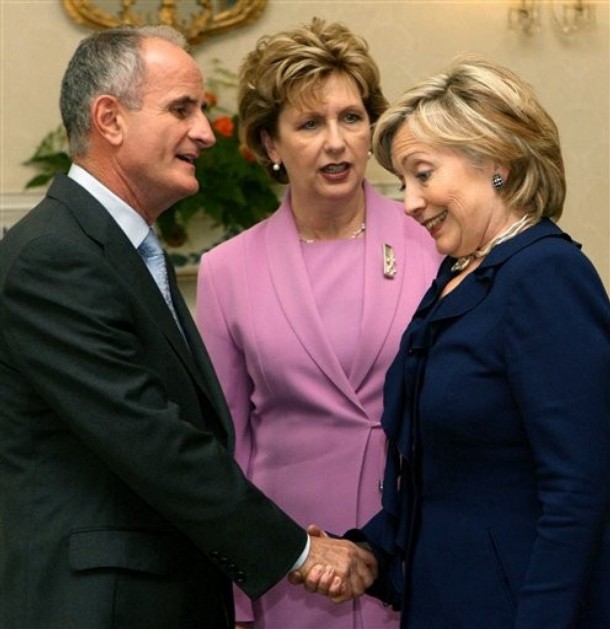Not long after leaving her post as President of Ireland, Mary Robinson, who was succeeded in 1997 by Mary McAleese, appeared on Oprah Winfrey's show and recounted a similar story as the post of president had been filled by a woman from 1990 when she succeeded Patrick Hillery until Michael Higgins succeeded McAleese in 2011. Can a man be president of Ireland? Well, it appears the answer is yes with the election of Higgins, but the more burning question among Irish women does not concern the presidency.
It is difficult for Americans to wrap our heads around the intricacies and hierarchies of parliamentary democracy. When Secretary of State Hillary Clinton visited parliamentary republics, we would see on her schedule a meeting with the president and another meeting with the prime minister with corresponding photos and statements at the end of the day.
The concept of prime minister v. president escapes us. To add to the mystery, Ireland does not actually have a prime minister, strictly speaking. That position goes by the title Taoiseach. Wikipedia explains the etymology thus.
In short, the head of government is the "chief," the head of state is the president, and the Irish Republic has not seen fit to assign a Gaelic title to the latter position which serves a purpose similar to that of a monarch in a parliamentary monarchy like the United Kingdom where the Queen is regarded, largely, as a figurehead. Linguistic matters aside, while we, stateside, have been impressed since the early 90s that the Irish have had two women presidents, the position itself is not a very powerful one leading Gabrielle Monaghan of the Independent to ask if Ireland will soon (or ever) have a woman Taoiseach.The words Taoiseach and Tánaiste (the title of the deputy prime minister) are both from the Irish language and of ancient origin. Though the Taoiseach is described in the Constitution of Ireland as "the head of the Government or Prime Minister",[nb 3] its literal translation is chieftain or leader.[9] Tánaiste in turn refers to the system of tanistry, the Gaelic system of succession whereby a leader would appoint an heir apparent while still living.
In Scottish Gaelic, tòiseach translates as clan chief and both words originally had similar meaning in the Gaelic languages of Scotland and Ireland. The related Welsh language word tywysog (current meaning: prince) has a similar origin and meaning.[2] Both derive ultimately from the proto-Celtic *towissākos "chieftain, leader".
Joan, Lucinda, Averil – could we ever have our own Iron Lady?
Gabrielle Monaghan
Two weeks after the last general election, readers of the New York Times were told Ireland had sworn in its first female Taoiseach. It was a false alarm, of course: the paper thought Enda Kenny was a woman.
But as the UK prepares for Margaret Thatcher's funeral, its first female prime minister, some question whether Ireland could ever have an Iron Lady of its own.
Female leaders are hardly a novelty in global politics; Germany, Australia, Iceland, Denmark, Argentina and Thailand all have a female prime minister. In the US, there is mounting speculation that Hillary Clinton will run for president in 2016.
After our next general election, also due in 2016, the odds of a woman being elected Taoiseach are 20-1, bookmakers Paddy Power calculated this week. But their odds lower dramatically for subsequent elections.
Read more >>>>Aside from the fact that this is Ireland, and for any forecast of anything happening in the world, one turns to the Irish bookies (they were very busy weeks ago during the conclave of the College of Cardinals), Monaghan finds the probability somewhat bleak despite legislation that requires representation within the parties.
The Government legislated last year to halve funding to political parties if they fail to make sure that at least 30pc of their election candidates are women, a measure that will take effect in time for the next general election.
At present, women account for just 15pc of Dáil seats, the same proportion as North Korea and behind Rwanda. At this rate, the National Women's Council had estimated, it would take 370 years before half the Dáil was female.Earlier this month, at the Women in the World 2013 Summit, Hillary Clinton, our own leading prospect for woman chief, said for the Nth time that the full participation of women in the economy and society is the unfinished business of the 21st century. She has been broadcasting this message around the globe for more than four years in addition to citing concrete examples of where women have been allowed (or have apprehended) egress and how that has aided societies.
While many of us have looked to Ireland as an example of a country where women have achieved the top rank, it is not, in fact, the case in the eyes of Irish women who still await their "Thatcher moment." So while so many in this country eagerly await a decision from Hillary Clinton on 2016, Irish eyes are fixed on 2016 in hopes of a female chieftain rising through the ranks and seizing the real power of government there.

